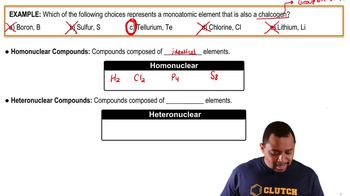Iron corrodes to produce rust, Fe2O3, but other corrosion products that can form are Fe(O)(OH), iron oxyhydroxide, and magnetite, Fe3O4. (a) What is the oxidation number of Fe in iron oxyhydroxide, assuming oxygen's oxidation number is -2? (b) The oxidation number for Fe in magnetite was controversial for a long time. If we assume that oxygen’s oxidation number is - 2, and Fe has a unique oxidation number, what is the oxidation number for Fe in magnetite? (O)(OH), iron oxyhydroxide, and magnetite, Fe3O4. (c) It turns out that there are two different kinds of Fe in magnetite that have different oxidation numbers. Suggest what these oxidation numbers are and what their relative stoichiometry must be, assuming oxygen’s oxidation number is -2.
Ch.20 - Electrochemistry

Brown15th EditionChemistry: The Central ScienceISBN: 9780137542970Not the one you use?Change textbook
Chapter 20, Problem 92a
Copper corrodes to cuprous oxide, Cu2O, or cupric oxide, CuO, depending on environmental conditions. (a) What is the oxidation state of copper in cuprous oxide?
 Verified step by step guidance
Verified step by step guidance1
Identify the chemical formula for cuprous oxide, which is \( \text{Cu}_2\text{O} \).
Recognize that oxygen typically has an oxidation state of \(-2\).
Let the oxidation state of copper in \( \text{Cu}_2\text{O} \) be \( x \).
Set up the equation based on the compound's neutrality: \( 2x + (-2) = 0 \).
Solve the equation for \( x \) to find the oxidation state of copper in cuprous oxide.

Verified video answer for a similar problem:
This video solution was recommended by our tutors as helpful for the problem above.
Video duration:
2mWas this helpful?
Key Concepts
Here are the essential concepts you must grasp in order to answer the question correctly.
Oxidation State
The oxidation state, or oxidation number, is a measure of the degree of oxidation of an atom in a compound. It indicates the number of electrons that an atom can gain, lose, or share when forming chemical bonds. In cuprous oxide (Cu2O), understanding the oxidation state of copper is essential for determining its role in the compound's formation and reactivity.
Recommended video:
Guided course

Oxidation Numbers
Cuprous vs. Cupric Compounds
Cuprous oxide (Cu2O) and cupric oxide (CuO) are two different oxides of copper, distinguished by the oxidation state of copper. In cuprous oxide, copper has an oxidation state of +1, while in cupric oxide, it has an oxidation state of +2. Recognizing these differences is crucial for predicting the behavior of copper in various chemical reactions and environmental conditions.
Recommended video:
Guided course

Homonuclear vs. Heteronuclear Compounds
Environmental Conditions and Corrosion
Environmental conditions, such as pH, temperature, and the presence of moisture or other chemicals, significantly influence the corrosion process of metals like copper. These factors determine whether copper will oxidize to form cuprous oxide or cupric oxide. Understanding how these conditions affect oxidation states helps in predicting corrosion behavior and developing strategies for prevention.
Recommended video:
Guided course

Ideal Gas Conditions Example
Related Practice
Textbook Question
Textbook Question
(c) What process occurs at the anode in the electrolysis of molten NaCl?
Textbook Question
(d) Why is sodium metal not obtained when an aqueous solution of NaCl undergoes electrolysis?
Textbook Question
(d) Why are active metals such as Al obtained by electrolysis using molten salts rather than aqueous solutions?
